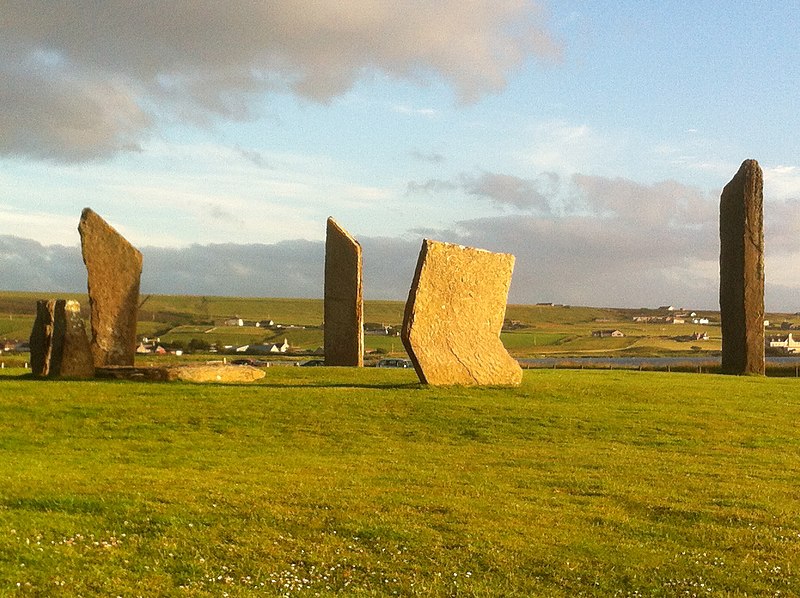
Image by michael clarke stuff from Wikimedia
10 Best Facts about the Standing Stones of Stenness
The Stones of Stenness are located in the Orkney Islands, on Mainland Orkney.
This iconic henge monument is one of the most famous attractions on Orkney.
It was put in place between 5,400 and 4,500 years ago, a period pre-dating Stonehenge.
Only four megaliths of the original twelve remain standing.
Twelve upright standing stones once made the circle at Stennes.
It was located in the very centre of the island, near the junction of Loch Stenness and Loch Harray.
Only three whole stones and one-half stone remain today, the highest of which rises at eighteen feet and nine inches.
The positions of the other twelve stones, on the other hand, are straightforward.
The reason why only four stones remain is a point of controversy.
The Standing Stones of Stenness is a Neolithic monument five miles northeast of Stromness on the mainland of Orkney, Scotland. It may be the oldest henge site in the British Isles.
Let’s go through the10 best facts about the Standing Stones of Stenness.
1. Standing Stones of Stennes might be the Earliest Henge in Britain

Image by Otter from Wikimedia
The Stones of Stenness may be the earliest henge monument in the British Isles, built about 5,400 years ago.
They probably hosted activities and ceremonies celebrating the relationship between the living and past communities. However, their function is unclear.
Radiocarbon analysis of bones found in the ditch surrounding the monument dated the monument to around 3100 – 2900 BC.
The 4m wide and 2m deep ditch was cut into the bedrock although it is no longer visible.
The stones were arranged in an oval shape, about 30m in diameter, set within this enclosure.
2. The Stones of Stennes is the Heart of Neolithic Orkney

Image by Chris from Wikimedia
A narrow causeway guarded by a 5.6-metre high “Watchstone” links Stenness Stonehenge to the Ring of Brodgar.
The Stones of Stenness are part of the Heart of Neolithic Orkney World Heritage Site.
Along with this monument and its surrounding standing stones, the general site includes Maeshowe Chambered Cairn, Skara Brae, the Ring of Brodgar and adjacent standing stones and burial mounds
The Stones of Stenness, Skara Brae and Maeshowe were built in the first part of the 3rd millennium BC.
The Ring of Brodgar was built about 500 years later.
3. Standing Stones of Stenness is a UNESCO World Heritage Site
The Standing Stones of Stenness are part of the UNESCO World Heritage site “The Heart of Neolithic Orkney”, which also includes the Ring of Brodgar, Maeshowe and Skara Brae.
Accessible all year round, it’s best to go either very early or late in the day, when these giant stones (up to 6 metres high) cast an impressive and eerie silhouette in the sunrise or sunset.
4. The Stones were Used for Various Rituals

Image by Francis Sylvester Walker from Wikimedia
Their function is that they were involved in activities and ceremonies celebrating the relationship between the living and past communities.
Traditions lingered through the ages that even in the 18th century the site was linked with rituals, then relating to Norse gods.
One stone, known as the “Odin Stone” had a circular hole and was also associated with other ceremonies and believed to have magical power.
The Odin Stone was very important to local folk. It had a hole through which you could pass a baby to prevent it from ‘shaking with the palsy’ (Parkinson’s Disease) in later life.
If you were ill you could pass the affected part of your body, or even your head, through the hole to be cured.
At the new year, young people would gather at the old Stenness Kirk, built in the 12th century, where they would party for four or five days.
Couples would slip away during that time and go to the Stones of Stenness, where the woman would pray to Odin. Then they would go to the Ring of Brodgar, where the man would pray.
Finally, they went to the Odin Stone, held hands through the hole and swore.
The Odin oath held firm.
5. The Standing Stones were Nearly Toppled to Clear Land for Farming

Image by Franz Bachinger from Pixabay
In December 1814 Captain W. Mackay, a farmer who owned land close to the stones, decided to remove them on the grounds that local people were trespassing and disturbing his land by using the stones in rituals.
but sadly the farmer was more interested in ploughing his fields
He started in December 1814 by smashing the Odin Stone, the most interesting of them all. This caused outrage and he was stopped after destroying one other stone and toppling another.
The toppled stone was re-erected in 1906. Today, the Standing Stones of Stenness remain a popular visitor attraction and remind us that even neolithic man could carry out tremendous feats of engineering!
6. Cows liked Scratching themselves on the Barnhouse Stone

Image by Stuart Wilding from Wikimedia
The Barnhouse Stone is located half a mile south of the Stones of Stenness in a field.
This solitary stone is easily identifiable. It is surrounded by a barbed-wire fence to keep it safe from itchy cows.
Cows used this rough stone as an itchy post before the fence was built. The public was concerned that this might loosen the stone and cause it to fall.
The name ‘Barnhouse’ comes from the name of the farm where the stone rests, which is the same as the neighbouring Barnhouse village.
Barns have nothing to do with the name.
7. The Standing Stones of Stenness are Linked to other Associated Properties

Stonehenge Image by Noah Jurik from Pixabay
Stone circles can be found all around the United Kingdom.
These structures range in size and most commonly hold connections to folkloric tales or practices and are usually regarded as sacred.
Many theories have been crafted over time concerning stone circles.
By linking stone circles in various places in the United Kingdom and their connections to folktales, cultural practices, and other various meanings, we are able to draw information regarding the importance of stone circles and begin to expand our understanding of a significant part of Britain and Ireland’s ancient material culture
These other sites include Maeshowe, Ring of Brodgar, Barnhouse Stone and Watchstone, and Skara Brae.
Relevance to other Orcadian Neolithic chambered tombs (in a general sense, but also in its close proximity to Unstan).
Ring of Bookan, Barnhouse and Ness of Brodgar Neolithic settlements, the former two as yet uninvestigated. Stone of Odin, Watch Stone and Barnhouse Stone.
Other stones circles and henge monuments in Historic Environment Scotland’s care elsewhere in Scotland, e.g. Cairnpapple, Machrie Moor, Calanais, Kilmartin Glen monuments. Avebury, Stonehenge.
8. The Outlier, Watch Stone

Image by August Schwerdfeger from Wikimedia
The Watch Stone is an outlier of the circle, standing eternal guard at the passageway between the Stones of Stenness and Ring of Brodgar. You’ll pass by this solitary giant as you cross the bridge.
It’s a large stone – 19 feet high (6.5 meters) – the same size as the stones within the circle.
The name, ‘Watch Stone’ is most likely a corruption of the Old Norse Vatnstein, meaning water/lake stone.
It may have been one of a pair. The stump of a second stone was found in 1930, some 42 feet away, by the side of the loch.
It was not aligned with the orientation of the Watch Stone but stood at an oblique angle.
The stump has been removed, so you can’t see it today.
9. The Standing Stones of Stennes are Storied Stones

Image by Gordon McKinlay from Wikimedia
The Watch Stone is one of three standing stones in Orkney that go for a drink at Hogmanay – New Year’s Eve.
Legend has it that the stone leaves its position at the stroke of midnight. It dips its head into the Stenness Loch for a New Year’s dram before returning to its rightful place.
It is said that if you try to watch the stone drinking then something will happen to prevent you from getting there on time.
One man who had moved to Orkney heard this tale from a local man and said that he would go and watch the stone have its drink that Hogmanay.
When they next met the local man asked him if he had seen the stone drink.
“Oh, no, something happened and I didn’t make it.”
“Ah!” said the local man. “The magic is still working.”
10. Archeological Evidence Shows Stones of Stennes Site were used for Habitation

Image by cowbridgeguide.co.uk from Wikimedia
In the centre of the ring is a hearth, and between the hearth and the enclosure entrance were two small stones and a larger ‘altar’ stone.
The most impressive thing about the largest stones – apart from their sheer height – is how slender they are. It scarcely seems possible that they could survive millennia without cracking apart, but they have.
The focus of the interior was the large hearth, which is still visible today. Its significance can be seen in the line of features marking the approach to the hearth.
- a paved path
- two stone settings
- a possible second hearth
It is also postulated that the three upright stones forming a ‘dolmen’ are probably just a reconstruction of a megalithic tomb.
Excavated pottery and animal bones show that Neolithic visitors cooked and ate food at the site.
The site’s true purpose is still unknown although it is believed to have been used for worship and ceremonies.
Life in the Orkney islands is, and always has been, steeped in tradition. Some of these customs remain strong while others have become mere shadows of their former selves – if not forgotten altogether.
As with our folklore, the islands’ various traditions revolved around the realities and demands of island life – the elements, work, the cyclical pattern of the seasons and the inevitable cycle of life – birth, marriage and death.
Planning a trip to Paris ? Get ready !
These are Amazon’s best-selling travel products that you may need for coming to Paris.
Bookstore
- The best travel book : Rick Steves – Paris 2023 – Learn more here
- Fodor’s Paris 2024 – Learn more here
Travel Gear
- Venture Pal Lightweight Backpack – Learn more here
- Samsonite Winfield 2 28″ Luggage – Learn more here
- Swig Savvy’s Stainless Steel Insulated Water Bottle – Learn more here
Check Amazon’s best-seller list for the most popular travel accessories. We sometimes read this list just to find out what new travel products people are buying.










